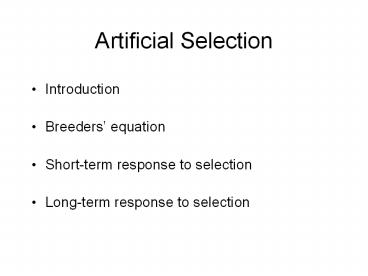Artificial Selection
1 / 36
Title: Artificial Selection
1
Artificial Selection
- Introduction
- Breeders equation
- Short-term response to selection
- Long-term response to selection
2
Artificial selection introduction
- Artificial selection, in the form of fancy
pigeons, was Darwins inspiration for the theory
of natural selection - Directly analogous to natural selection
- Fitness largely defined by experimenter
- Darwinian fitness still involved
3
Artificial selection deterministic change in
allele frequencies
- Effect of selection depends on s and the initial
frequency of q.
4
Dominance and selection
- Dominance is not heritable (individual alleles
inherited from each parent, not pairwise
combinations) - However, dominance clearly plays a role in
selection
5
Dominance and Selection I
Dq
- Change of gene frequency with s 0.2, for
different values of initial gene frequency q. - Upper panel no dominance lower panel, complete
dominance - Selection against q
- Selection for q
Dq
q
6
Dominance and Selection II
q
- Change of gene frequency during the course of
selection from one extreme the other, with s
0.2. - Upper panel no dominance lower panel, complete
dominance - Selection against q
- Selection for q
q2
Generations
7
Additive variation
- Because alleles are inherited singly, artificial
selection concerns itself with additive
variation, thus h2.
8
Artificial selection is
- the deliberate choice of a select group of
animals or plants, usually superior for a trait
or traits, for breeding - Three major outcomes of artificial selection
- Change in mean of selected trait
- Change in variance of selected trait
- Change in traits covarying with selected trait
9
Artificial Selection
- Introduction
- Breeders equation
- Short-term response to selection
- Long-term response to selection
10
The breeders equation
- Consider a random mating population. Plot
offspring y vs. midparent x in this population.
11
The breeders equation
- R mean difference between offspring and
population before selection - S mean difference between selected parents and
population before selection - R ,S lies on the parent-offspring regression
R
S
12
The breeders equation I
- R ,S is the mean of the selected parents and
their offspring - R/S is the slope of the line, the
parent-offspring regression - Thus
- Or, R h2S
13
The breeders equation II
14
The breeders equation II
15
The breeders equation II
16
The breeders equation II
17
The breeders equation II
18
Why is offspring mean always less than parent
mean?
- Because (a trivial explanation)
- So why not
- Alleles, not genotypes, are inherited
- Dominance and epistasis
- Good phenotype can be result of environment
19
What is required for the breeders equation to
work?
- Good estimate of h2
- Standardize effects of environment between
generations - No change in allele frequencies between
generations (natural selection, mutation, drift)
20
Factors that influence S
- Proportion selected
- High proportion, S small
- Low proportion, S large
21
Factors that influence S
- Phenotypic variance
- VP large, S small
- VP small, S large
22
Dimensionless variables
- We can compare responses of different traits,
organisms if we avoid using phenotypic units (mm,
kg, days, etc.) - Standardize to R and S to the phenotypic standard
deviation
23
Dimensionless variables II
- Divide through by the phenotypic standard
deviation - the intensity of selection
24
Improving the response to selection
- Increase h2
- Decrease environmental variance
- Decrease measurement error
- Increase i
- However, risk increasing inbreeding
25
Measurement of response to selection
- Response seldom linear
- Stagger due to drift, environmental fluctuation,
sampling error, differences in i - Thus need several generations to measure R well
24 22 20 18 16 14
Generation mean, in grams
2 4 6 8 10
Generations
26
Environmental fluctuation
- Control statistically by maintaining contemporary
unselected (control) or divergently selected
population - Environmental fluctuation should affect selected
and control (or divergently selected) lines
equally
27
Artificial Selection
- Introduction
- Breeders equation
- Short-term response to selection
- Long-term response to selection
28
Replication of selected lines
- Multiple reps. of control, selected lines are
kept to control for genetic drift - Multiple reps. essential for study of correlated
response to selection - Repeatability of reps. high Vrep many low
frequency alleles in base pop.
29
Realized heritability
- Realized h2 cumulative selection
response/cumulative selection differential - Best measurement of effectiveness of selection
- Comparable between experiments/traits
- Best predictive nature
30
Symmetry of selection response
- Requires up and down selected lines
- Asymmetry can give information about constraints
on the trait
31
Causes of asymmetry in selection response
- Selection constraint natural selection could
enhance selection in one direction, inhibit it in
the other - Chance control by using multiple reps.
- Inbreeding depression mean decreases with
inbreeding depression, therefore down selection
appears more effective - Extreme initial allele frequencies in base
population
32
Artificial Selection
- Introduction
- Breeders equation
- Short-term response to selection
- Long-term response to selection
33
Long-term response is hard to predict
- Theoretically, in a finite population with no
mutation, response to selection should be finite
eventually all up alleles will be fixed in the
up line, etc. - However, new mutations occur continually,
therefore response should occur indefinitelybut
slowly
34
Generalities about long-term response
- Response does continue for a long time 20-30
generations - Response to selection in the range of 10-20 i.e.
generating individuals far more extreme than ever
seen in base population
35
Response to selection does not proceed
indefinitely I
- Mutations occur too rarely
- Mutations pushing trait beyond extreme are too
deleterious (constraint)
36
Response to selection does not proceed
indefinitely II
- Dominance variation
- Overdominance (heterozygosity required for
phenotype, equilibrium allele frequency reached) - Negative pleiotropy

